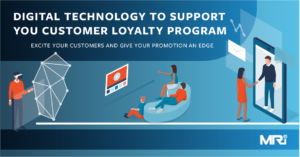Without some form of a reward, what incentive is there for consumers to join a loyalty program? With more and more brands offering exciting and innovative rewards, you must differentiate your program in order to compete and retain loyal customers. As experts in the business, we’ve identified three key customer loyalty program tips to encourage greater participation.
The three main motivations for consumers to join a loyalty program are; the opportunity to earn points towards rewards, saving money, and earning prizes.
Points
Adding a points system to your loyalty program can be a fun way to incentivize your consumers. “86% of shoppers said they’ve joined a loyalty program to collect points for rewards” (Kobie). When done correctly, points can engage your loyalty program members in ways that just aren’t possible with discounts and rewards.
There is a lot of interesting psychology behind creating a successful points system. Per the ‘Goal Gradient Effect’, people tend to work harder towards a goal the closer they are to achieving it. Researchers from Columbia University have studied this effect on loyalty points systems, and found that “members purchased more frequently the closer they were to earning a reward, and a stronger tendency to accelerate toward the goal predicts greater retention and faster reengagement in the program” (Columbia.edu). Thus, displaying how many points a user has and how close they are to their next reward is imperative to any loyalty program.
Bloomingdales’ points system puts the goal gradient effect into good use. The department store chain rewards consumers with 1 point for every dollar spent (with double & triple point events to create even more purchase incentive). In their app, consumers can see a visual of how close they are to their next reward, as well as the specific number listed underneath.
While a points system may seem like a no-brainer, for some industries it may not be the best way to reward members. For example, 76% of restaurant guests note immediate benefits are more appealing than accumulating points (Oracle Hospitality). As always, be sure to research how a points system could benefit your specific industry.
Save Money
The second most common type of incentive for a loyalty program is to save your consumers money. Discounts can have a huge influence on a customer’s brand loyalty. By giving consumers discounts with your loyalty program, you can not only increase loyalty with current members, but you can also grow your customer base. 77% of shoppers say discounts can influence where they shop, and 48% say they can speed up the decision-making process (RetailMeNot).
For a loyalty program, exclusivity can be an extremely effective tool to make your members feel rewarded (54%) excited (47%), and special (36%) (Kelton). By giving exclusive discounts & coupons to your loyalty members, you can increase the rate at which members redeem these offers. “94% of Americans would take advantage of an exclusive offer provided by a brand that the brand would not typically offer the general public” (Kelton).
Cinemark’s loyalty program “Cinemark Movie Club” has multiple exclusive member discounts. Member benefits include:
- One credit for a 2D movie every month. Any unused tickets rollover.
- Pay member pricing for any additional tickets throughout the month
- 20% discount on concessions for every visit
- Reserve and buy tickets in advance with no online fees
Despite its $8.99 monthly fee, the Cinemark Movie Pass has seen great success. In its first year, the loyalty program surpassed 500,000 members. This was a huge accomplishment for the movie theatre chain as it more than doubled its initial projections. In addition, Movie Pass members’ engagement with the program was high, at a 75% credit redemption rate, and 98% of members reported having a positive satisfaction with the rewards.
- Discounts and coupons came in as the top-ranking tactic for driving loyalty with 61% of consumers saying they use them (Expedia Affiliate Network)
- Two-thirds of shoppers will either not shop without a discount or will look for discounts before they begin shopping (RetailMeNot)
Prize Rewards
And lastly, who doesn’t want a good old-fashioned prize? Unlike a points system, loyalty programs that reward prizes typically involve an element of chance- for example, a sweepstakes, giveaway, or an instant win game. Whether it’s cash, an all-expense-paid trip, event tickets, branded items, or more, receiving a prize can make winners feel rewarded. The prizes you give your members can affect the success of your loyalty promotion, so nailing the right type of reward for your consumers is a must. The obvious choice most consumers would like as a prize would be cash or gift card, however, a lot of brands have seen success with other prizes as well. It all comes down to understanding your customer to know what prize will resonate best with them.
Previously, Chipotle ran a promotion, in partnership with Venmo, to kick off their new loyalty program. They rewarded customers by depositing cash directly into their accounts. Customers could visit the promotions microsite and enter the phone number associated with their Venmo account to enter. Each customer had a chance to instantly win anywhere between $1 and $500. As one of the first brands to use Venmo’s payout feature, the promotion received a lot of media attention & positive social feedback.
Conclusion
By providing extra incentives to your loyalty program, you can motivate more consumers to participate in your customer loyalty program. With these three tips, we hope you feel more confident strengthening your connection with your consumers in your next customer loyalty program. For more ways to amp up your loyalty program, contact us.





